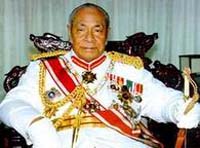Tonga buries its beloved king
Tonga, the tiny Pacific island nation, has plunged into mourning as it buried its beloved King Taufa'ahau Tupou IV in an elaborate state funeral. The funeral mixed tribal traditions with Christian prayers, royal pomp with village-style feasts.

Led by his son and successor, King Siaosi Tupou V, dignitaries from 30 nations lay wreaths and joined an estimated 20,000 people in a three-hour Wesleyan Christian funeral service at the Tongan Royal Tombs, Mala'e Kula.
One thousand pallbearers escorted the coffin on its 500-meter (yard) journey from the beach-side royal palace to the funeral site as mourners lining the route sat silently. Tongans dressed in black and wore traditional mourning mats called ta'ovala wrapped round their waists.
Tupou IV died at age 88 in a hospital in the northern New Zealand city of Auckland on Sept. 11, plunging this nation of 114,000 into a month of official mourning. His body was flown back to the kingdom Sept. 14 to lie in state.
In the Tongan capital, black and purple mourning cloth festooned buildings, roadsides, and even palm trees, marking the biggest royal funeral since 1965 when Queen Salote, Tupou IV's mother, was buried.
Japan's Crown Prince Naruhito, the Duke and Duchess of Gloucester representing Britain's Queen Elizabeth II, the prime ministers of New Zealand and Fiji, the President of French Polynesia and governors general from Australia and New Zealand were among international dignitaries.
Church groups began singing hymns Monday night and continued until dawn Tuesday. Surfboard riders stashed their boards in respect to a king who was himself a surfer. Government and many private businesses closed for the day.
Thousands honored their beloved king, many bearing traditional gifts of huge woven mats, baskets, fabric and painted tapa cloth made from the bark of the paper mulberry tree.
Gifts of food have also flooded in to feed thousands of mourners in the capital where huge earth ovens, or umu, lined with hot rocks have been used to cook it.
As the funeral procession passed, hundreds of school students who lined the path sat silently. Crowds of other Tongans sat under open-sided marquees lining the route.
The service included traditional rites as well as Christian prayers.
At the burial site, 40 men assigned as undertakers - or nima tapu - lay the king in the royal tomb. Until 300 years ago, the nima tapu would be strangled or have their hands severed after a funeral because they had touched royalty.
Mourner George Hurrel, who attended the funeral of Queen Salote, who is still a much-loved figure in Tonga, said Tuesday's funeral - and the nation's sense of loss - was just as great.
"We loved Queen Salote as much as we do our king," Hurrel, 75, said.
Like the vast majority of mourners, Sina Fiafia, a 26-year-old housewife from the capital, sat throughout the service silently and somberly, keeping her grief in check under a gray sky.
"We will tell our grandchildren about this day and about King Tupou IV" for the rest of the century, she said.
Tupou IV's 41-year reign made him one of the world's longest-serving sovereigns, after Thailand's King Bhumibol Adulyadej, Britain's Queen Elizabeth II and Samoa's King Malietoa Tanumafili II.
Although Tupou IV was criticized as too autocratic toward the end of his reign, Tongans credit the late monarch with transforming the poverty-ridden nation from a village-based economy to a regional and international trade economy.
An official obituary note said the late king "gave us the leadership and many of the ideas that transformed the kingdom and took it into the modern age."
Tupou IV had begun democratic reform in the feudal kingdom, a process Tupou V will be under pressure to continue.
Tupou V arrived at his father's funeral Tuesday in his trademark black London taxi dressed in the green uniform of the commander in chief of the Tongan Defense Services, the AP reports.
Three hundred troops and naval personnel in full dress uniforms with black armbands slowly marched ahead of the king's flag-draped coffin, which pallbearers carried at shoulder height on a 15-meter (50-foot) long traditional funeral platform known as a catafalque.
Subscribe to Pravda.Ru Telegram channel, Facebook, RSS!





